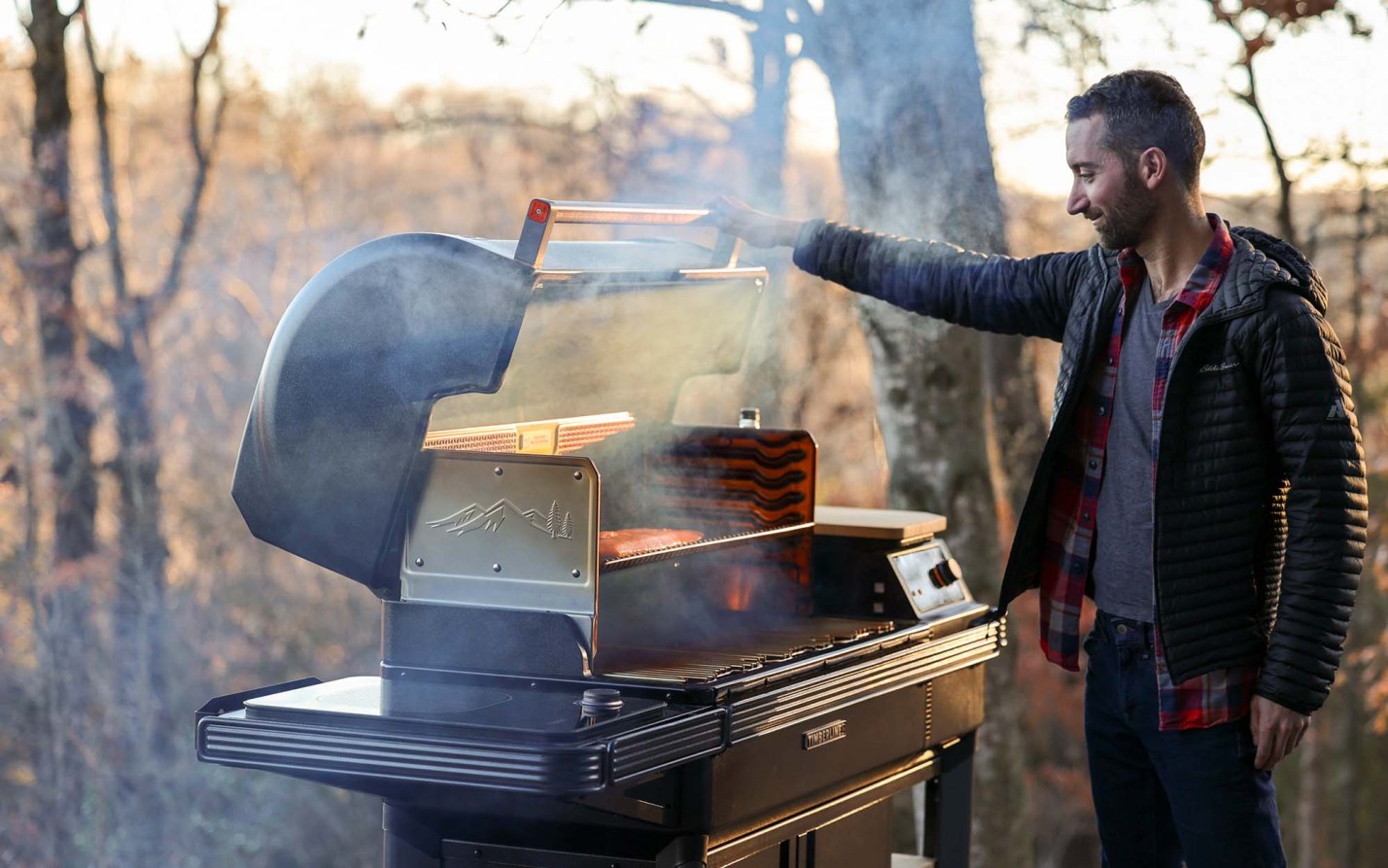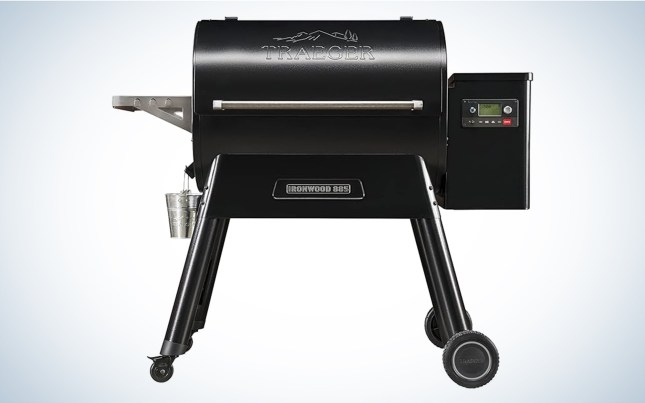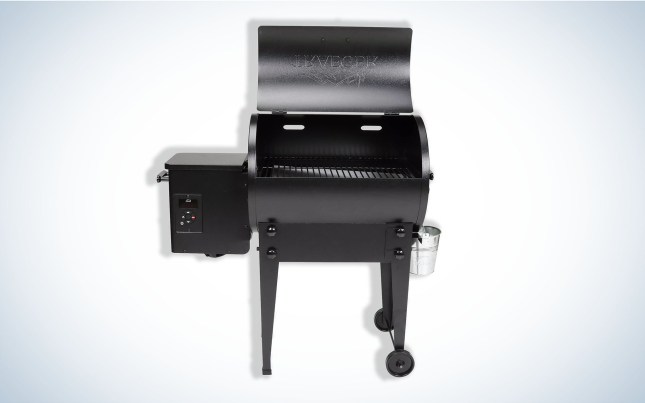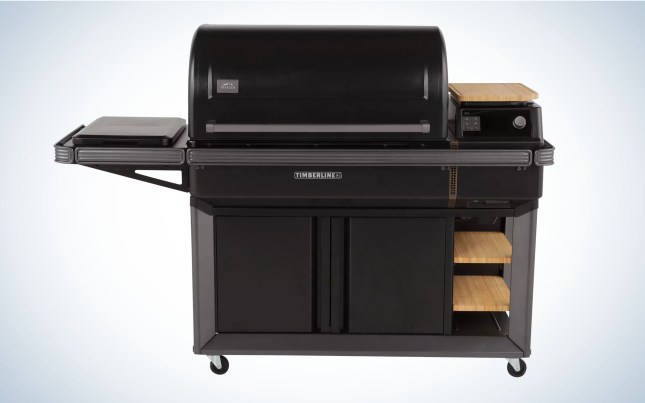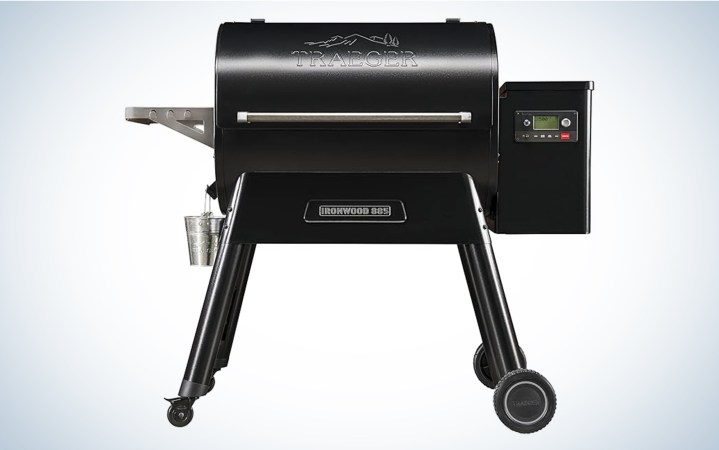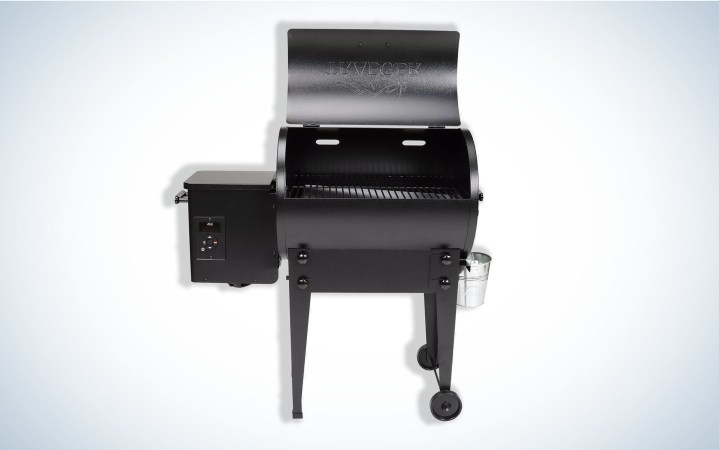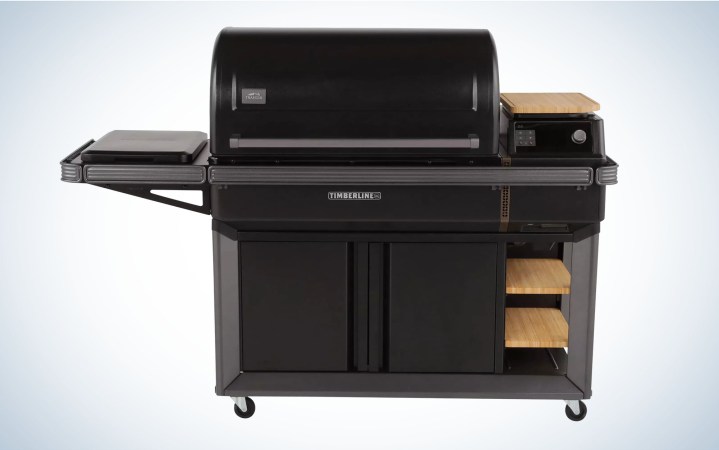We may earn revenue from the products available on this page and participate in affiliate programs. Learn More ›
I resisted hopping on the Traeger grill bandwagon for ages. Trendy though they are, smokers seemed unnecessarily complicated, took forever to cook anything, and were only useful for all-day briskets, something I don’t have time for. Then I actually started using one. For a home cook like me (someone with a freezer stuffed full of wild game and an allergy to any kind of cooking besides cast-iron and grilling) smoking meat is the solution to all my culinary woes. As a general rule, the best Traeger grills are simple to use, require very little active prep time, and produce reliably delicious results.
- Best Overall: Traeger Ironwood 885
- Best Portable: Traeger Tailgater
- Best Splurge: Traeger Timberline XL
- Traeger Ranger Grill
- Traeger Pro 575 and 780
- Traeger Flatrock
How I Tested the Best Traeger Grills
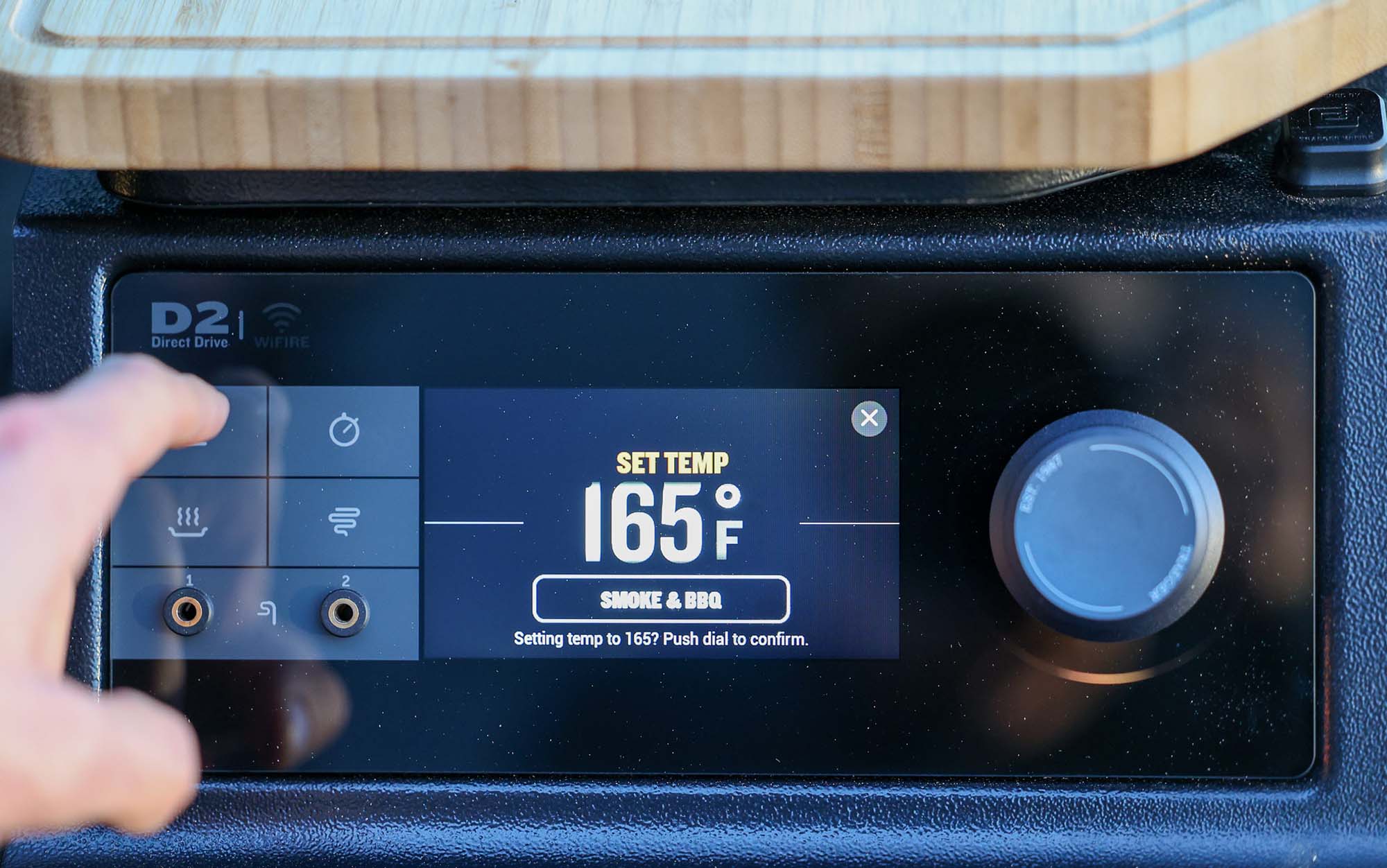
Natalie Krebs
In our testing of the best Traeger grills, we recruited editors with a range of culinary skills and experience with Traegers to grill, smoke, and sear a variety of meat (domestic and wild), vegetables, and other dishes. We considered the price, the design, the features, any built-in technology, and whether the grill meets the niche grilling purpose for which it was designed. We caught our Traeger grills on fire, towed them across the country, and tried to induce malfunctions. Where possible, we considered the durability of a grill over time. As we test more Traeger grills, we will add those reviews to this article, too.
Best Traeger Grills: Reviews & Recommendations
Best Overall: Traeger Ironwood 885
Key Features
- Total Cooking Space: 885 square inches, or eight whole chickens
- Total Weight: 175 pounds
- Pellet Hopper Capacity: 20 pounds
- Max Temperature: 500°F
- Min Temperature: 180°F
- Wi-Fi: Yes
- Double side wall insulation
- Includes a meat probe
- Super Smoke mode
- Price: $1,500
Pros
- Great for using as a smoker or outdoor oven
- No issues with pellet jams
- Easy to clean
- Great flavor and results when smoking
Cons
- Not great for searing
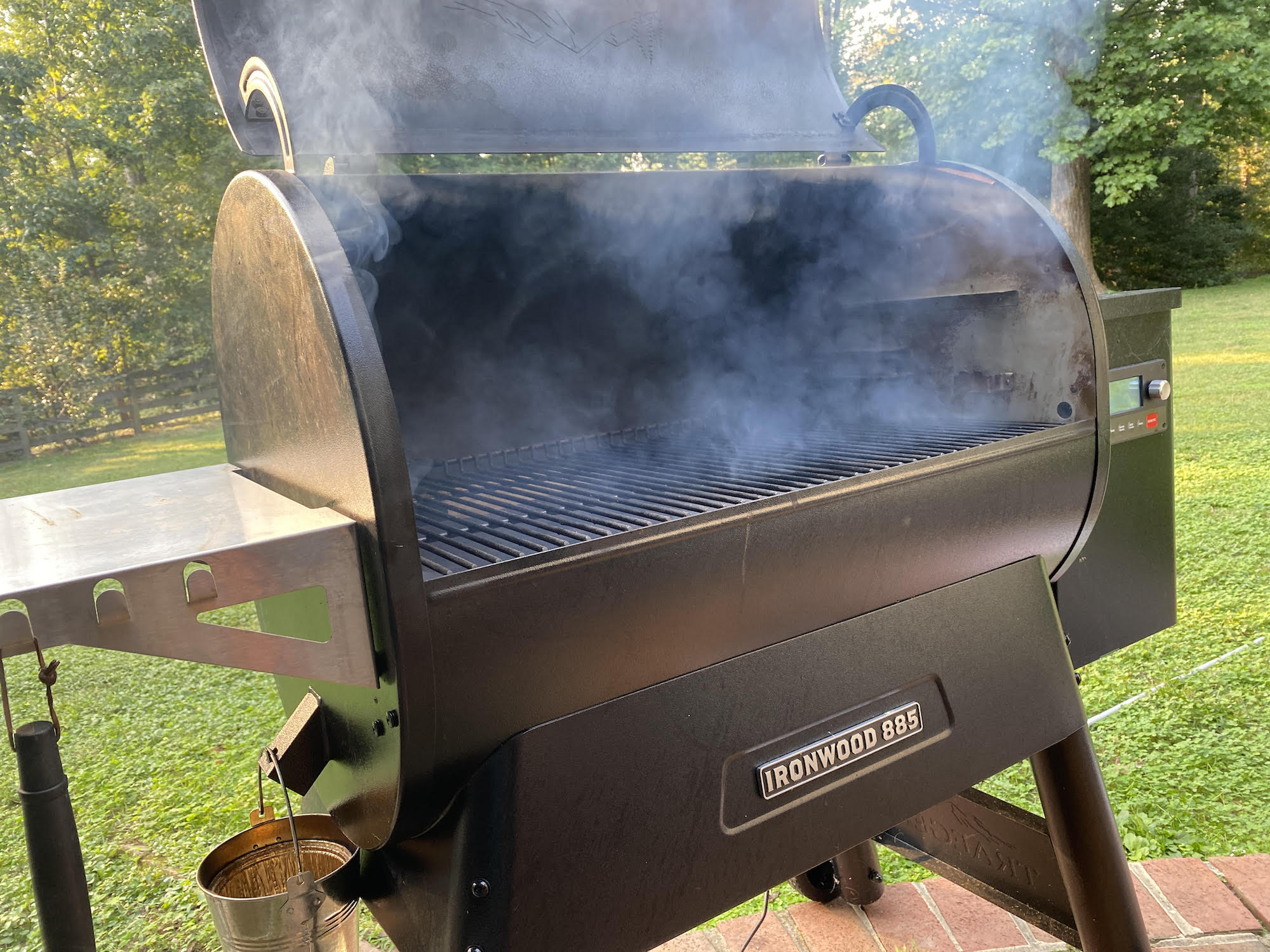
I deeply appreciate wood cooking, and my dream smoker is the Franklin BBQ Pit. But I’m also a busy dad with grass to cut, and even if I had all day to monitor a cook, I’d spend that time fishing. That’s why I use a Traeger Ironwood 885. If I’m doing a 12-hour brisket, all I have to do is fill the hopper with pellets and set my temp. I can monitor the smoker and the internal temp via the Traeger app. It’s about as easy as using a crockpot, and the resulting BBQ is consistently delicious.
The Ironwood has a Super Smoke Mode, which fills the smoker with plumes of white, hardwood smoke. It’s a nice feature for getting a defined smoke ring on the BBQ or quickly adding smokiness to vegetables, seasonings, and sauces. I use it for turning jalapeños into chipotles and making smoked sea salt.
My main complaint about the Ironwood is that it isn’t the best at searing meat. You can achieve decent grill marks, but it’s not the same Maillard reaction you get from a hot charcoal grill. If you want to grill on the Ironwood, my advice is to drop the grate down to its lowest position, turn the temp up all the way, and let it preheat for 15 minutes.
Why the Ironwood? The Ironwood sits in the middle of the Pro and Timberline. I went with the Ironwood 885 over the Timberline because it’s cheaper and has nearly identical features except that the Ironwood is a little lighter and holds four fewer pounds of pellets. (Traeger has recently updated the Ironwood line with a standard Ironwood at 616 square inches of cooking space, and an Ironwood XL, at 924 square inches.) The Traeger Pro line doesn’t have the Ironwood’s extra insulation, which I thought could be an issue while cooking in cold weather. —Scott Einsmann
Best Portable: Traeger Tailgater 20
Key Features
- Total Cooking Space: 300 square inches, or two whole chickens
- Total Weight: 62 pounds
- Pellet Hopper Capacity: 8 pounds
- Max Temperature: 450°F
- Min Temperature: Approximately 180°F
- Wi-Fi: No
- Keep warm mode
- Meat probe included
- Digital arc controller
- Porcelain-coated grill grates
- Price: $530
Pros
- Lightweight and easy to maneuver
- Easy to use, plug it in and turn it on
- Durable and quality build
Cons
- Temperature and pellet hopper need to be monitored
- Requires thorough cleaning after each use
I’ve had my Traeger Tailgater 20 liter since I graduated college six years ago. It’s weathered four moves, crossed state lines with me five times, and even endured a trip to South Dakota where I used it to smoke more than 100 pounds of bacon in five days. I’d be the first to admit: I never thought it would last this long. But it’s held up admirably.
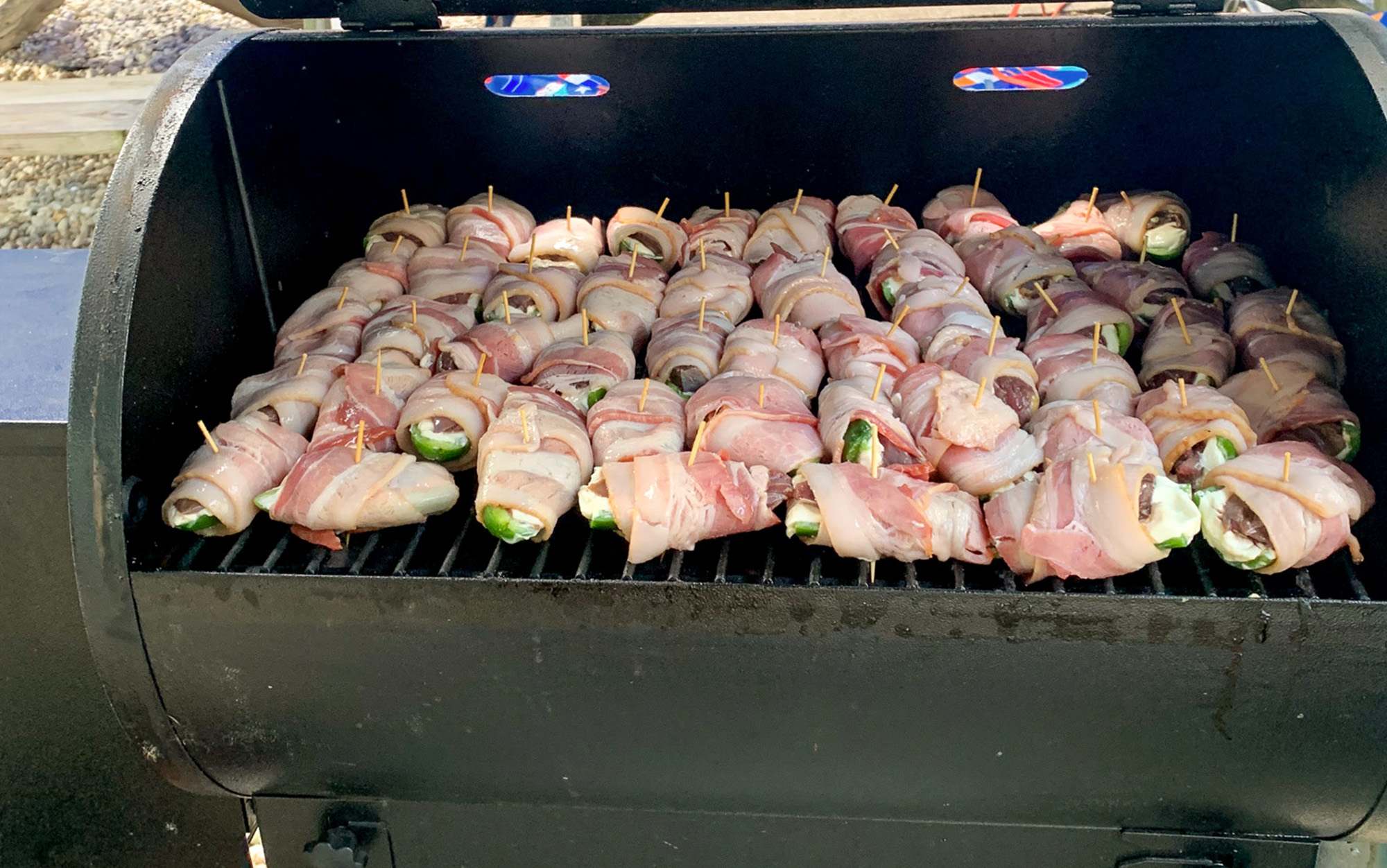
Derek Horner
When I first bought the Tailgater, I needed a smoker to make venison pastrami and dove jalapeño poppers. I also bought two 20-pound bags of pellets (one applewood, and one hickory). I expected to blow through the pellets and within a year or two, have to buy another smoker. The tailgater 20 redefined those expectations. I’ve conservatively smoked more than 1,000 pounds of meat in the past six years, and have used surprisingly few pellets to do so. (I use about 1 pound of pellets per hour at lower temperatures—my optimal smoking temp.)
The downsides of the Tailgater are to be expected with this type of smoker. You cannot set it and forget it like the higher-end Traegers since the temperature and pellet hopper need to be monitored, as the temperature tends to fluctuate. You must also clean the ash out of the burner regularly to avoid fires. (I’ve caught mine on fire three times by neglecting this. Six to seven hours of smoking without cleaning led the ash to catch; then the grease and drippings helped fuel the fire. Thankfully, I was able to just turn off the grill and the fire settled down.)
Since I bought my Tailgater, Traeger has upgraded it with a keep warm mode and an included meat probe. Overall the Traeger Tailgater 20 is lightweight, easy to maneuver, delivers plenty of bang for your buck, and doesn’t take up much space in the bed of my truck. —Derek Horner
Best Splurge: Traeger Timberline XL
Key Features
- Cooking Space: 1,320 square inches, or 12 whole chickens
- Max Temperature: 500°F
- Min Temperature: 165°F
- Pellet Hopper Capacity: 22 pounds
- Total Weight: 289 pounds
- Warranty: 10-year limited warranty
- Wi-Fi: Yes
- Super Smoke Mode
- Induction cooktop
- Touchscreen controls
- Two Meater probes included
- Customizable storage and accessories rail
- Price: $3,800
Pros
- Technology is useful and idiot-proof
- Packed with fancy features like an induction cooktop for searing
- Hands-off cooking with excellent results for any level cook
Cons
- Pricey
- Very heavy
The Timberline XL is a beast in every sense of the word. It’s heavy, it’s expensive, and it’s every home smoker’s dream.
Traeger makes two Timberlines: the standard model and the XL, which I tested. (They share identical features, but the XL has an additional 440 square inches of cooking space.) My Timberline XL arrived pre-assembled so I can’t speak to the ease of setup, but I do know it was a bear to maneuver into position on my back patio even with the wheels. Still, you only have to assemble your grill once, and the slick features packed into the Timberline are worth the workout if you aren’t planning to move anytime soon (indeed, this model is designed to be permanently built into an outdoor kitchen).
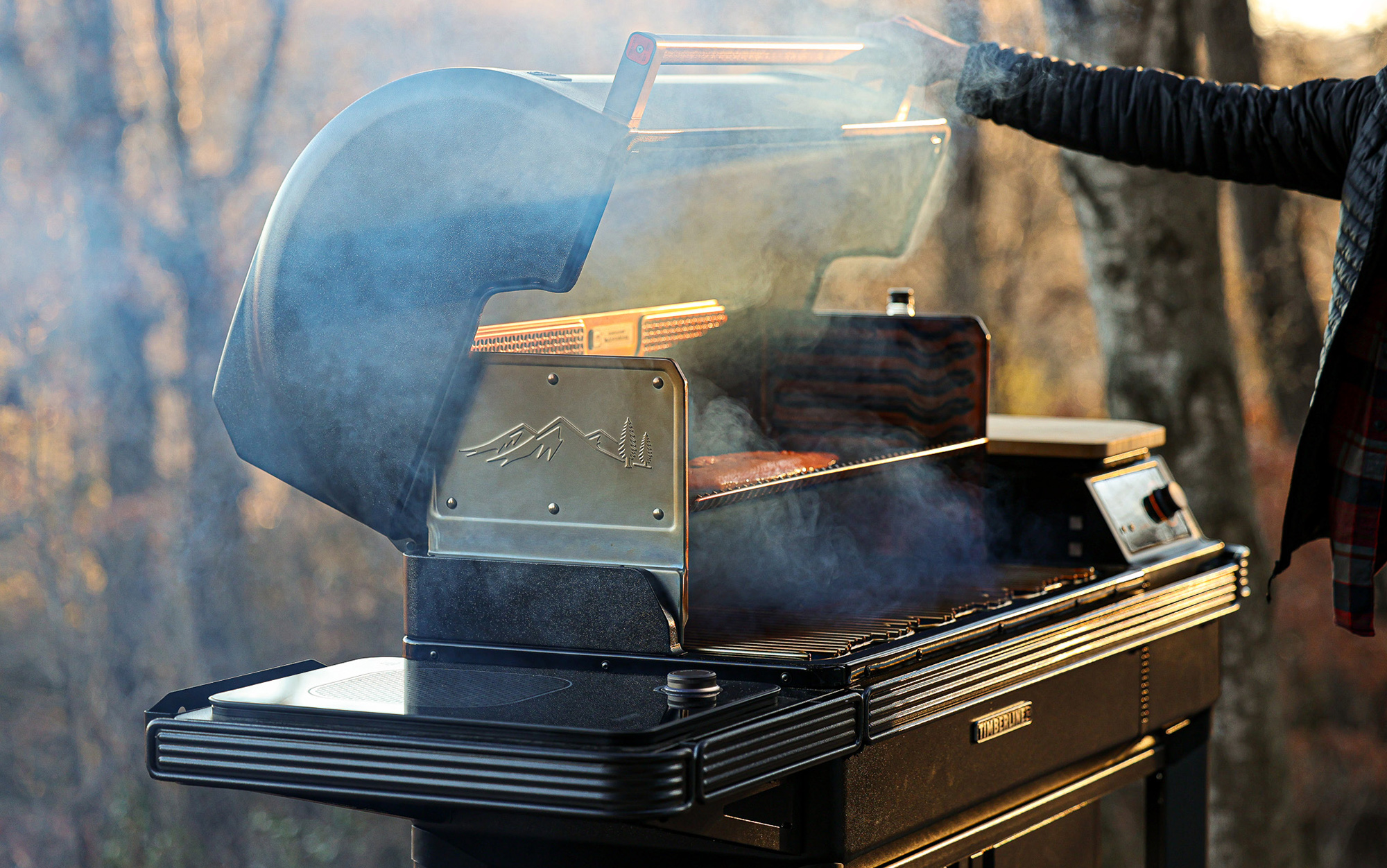
Natalie Krebs
The idea of fussing over a kettle smoker or high-maintenance pellet grill all day is not my idea of fun, and Traeger thought of everything with this smoker so you don’t have to. It monitors everything—grill temperature, pellet level, internal meat temperature—and relays those details to you on the built-in touchscreen and in the app. When I stepped outside after dark to check the pellet levels against the digital readout, a built-in light illuminated the hopper’s interior. There’s a covered induction cooktop for searing or cooking other sides, and ports for wired probes if you forgot to charge the two included Meater wireless probes.
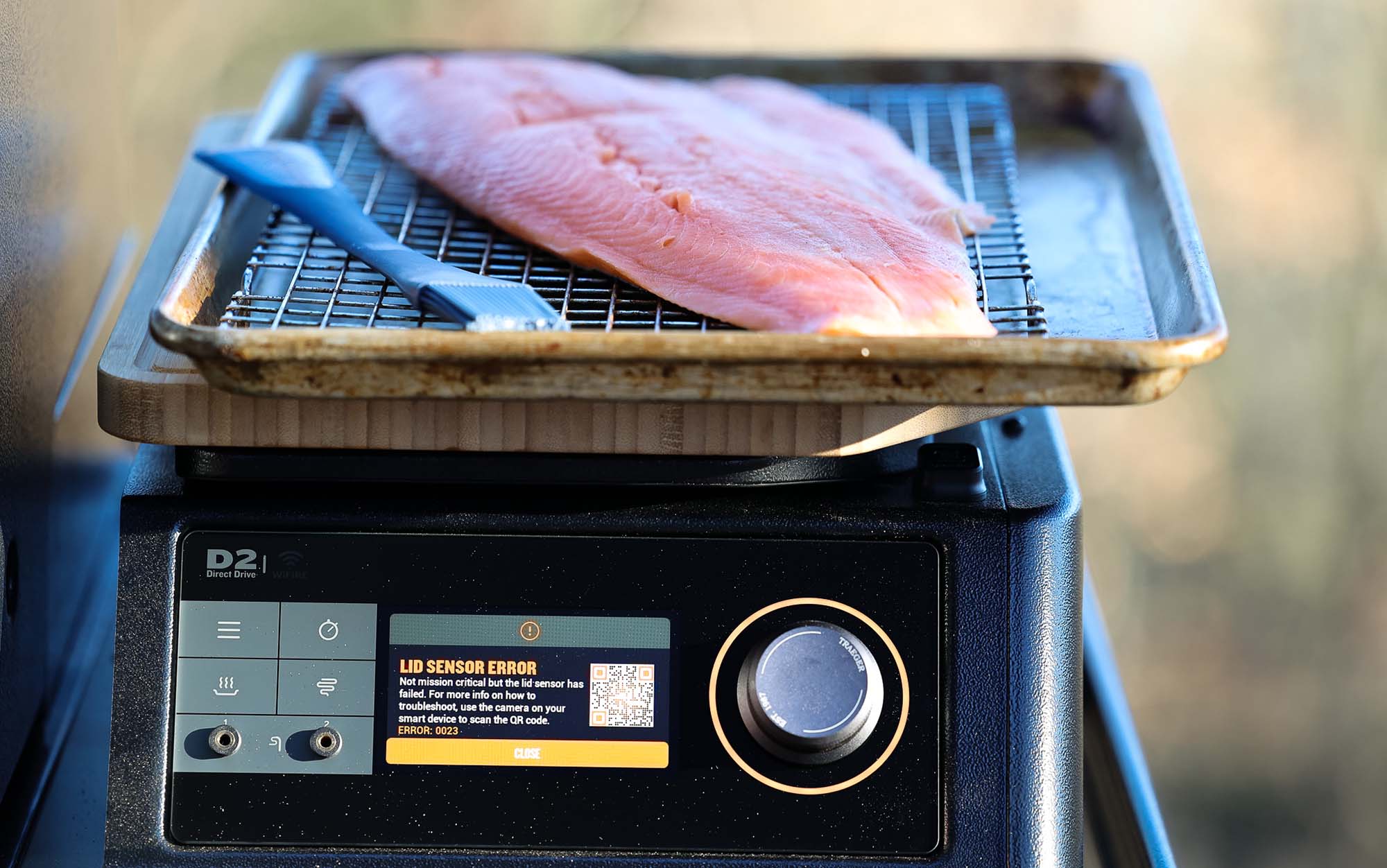
Natalie Krebs
On my first cook (smoking a slab of brined trout) I had some trouble with the grill lid sensor, but a QR code popped up on the grill’s touchscreen and directed me to a handy troubleshooting page, where I quickly resolved the issue (a magnet misplaced during assembly). I was also pleasantly surprised to find that, like older model gas tanks, the hopper readout consistently underestimated actual levels. It’ll be interesting to see how well all these digital bells and whistles hold up over time.
Trageger’s Timberline XL is sophisticated enough to accommodate any kind of cook, and its idiot-proof touch screen and app integration make preparing dinner a pleasure not a chore. —Natalie Krebs
More of the Best Traeger Grills
Although we have yet to get our hands on these models for testing, here are additional grills that fill out the rest of Traeger’s lineup:
Traeger Ranger Grill
The Traeger Tailgater Ranger is a portable smoker (think six burgers) to stash in your truck for car camping and grilling brats after a morning on the slopes.
Traeger Pro 575 and 780 Smoker
The Pro is the more affordable workhouse smoker out of Traeger’s line, with the same features available in 575 or 780 square inches of cooking space. These models are a step up from the Tailgater with the trademarked “set it and forget it” Wi-Fi and app integration for monitoring your smoker.
Traeger Flatrock Grill
If you want a beefy flat-top griddle for whipping up plates of bacon or a batch of smash burgers, then Traeger’s Flatrock series is worth considering.
How to Choose the Best Traeger Grill
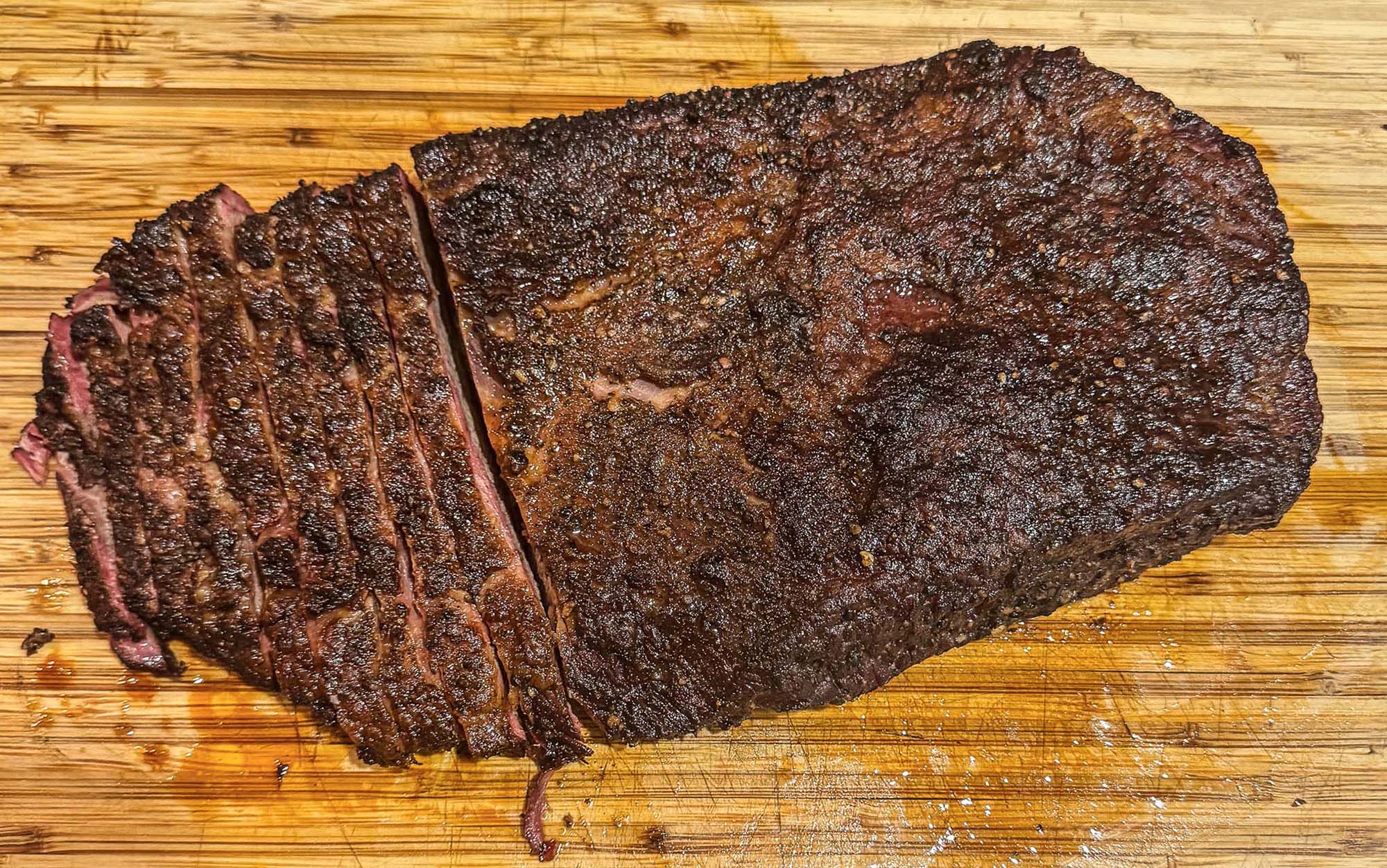
Natalie Krebs
While Traeger offers many different grills, each is purpose-built for a certain type of home cook. You should consider the kind of cooking you plan to do, plus your budget: Traeger grills range from a few hundred dollars to nearly $4,000, not to mention the additional cost of essentials like wood pellets. If you’re interested in a basic smoker for the dove opener and deer camp, one of Traeger’s portable grills is your best bet. If you’re a weekend warrior, consider one of the Pro or Ironwood models.
However, if you prefer smoking and grilling to almost any other kind of cooking and regularly host BBQs, you may want to go big with a Timberline. If you’re not interested in smoking BBQ and you want a griddle instead, then you can’t go wrong with the Flatrock. Once you’ve decided what line of grill is right for you, consider the capacity. Traeger offers most of its grills in two sizes so you don’t have to pay for cooking space you’ll never use.

FAQs
Each Traeger grill has different cleaning procedures depending on which model you have, but in general, the goal is to clean away ash and grease using rags, paper towels, a grill scraper, and a non-flammable cleaning product like Traeger’s grill cleaner. Remove the grates, drip tray liner, drip tray, and heat baffle, then use a shop vac to vacuum the inside of the grill. Spray the grates, inside of the chimney, and the walls of the grill with the grill cleaner. Let it soak, then scrub clean using a bottle brush for the chimney, a scraper for the grates, and paper towels for the other surfaces. Replace the heat baffle and drip tray, then insert new drip tray and bucket liners. Replace the grates, and you’re finished. (Watch the video above for a detailed cleaning procedure.)
The lifespan of a Traeger grill depends on how well you care for your grill. One of our testers has had his Traeger smoker for six years and, despite setting it on fire three times, it’s still going strong. Check the warranty information on any Traeger you’re considering, which will also give you an idea of how long the company will back its product. The new Timberlines and Ironwoods come with a 10-year warranty against rust for certain parts, with 2- and 3-year warranties against manufacturing defects on other components, like the pellet sensor and auger motor.
Yes, you can use certain Traeger models as an everyday grill depending on your cooking style. If you’re only interested in a grill that fires up in 10 minutes so you can sear a couple steaks, you’re better off saving your money and purchasing a gas grill. But if you don’t mind longer cook times, you can regularly use a Traeger for everyday grilling. (Traeger’s roasted beer-can chicken takes 1 hour and 45 minutes, and that’s one of the fastest meat recipes they recommend.) Still, a Traeger is best suited for weekend barbecuing when you have the time and energy for slower cooks.
Final Thoughts
The best Traeger grills are the ones that work best for how you like to cook. Smokers are ideal for homemade BBQ, but you can do much more than just grill meat on a Traeger. If you’re interested in adding one to your backyard, deck, or patio, check out one of these top options.
- Best Overall: Traeger Ironwood 885
- Best Portable: Traeger Tailgater
- Best Splurge: Traeger Timberline XL
- Traeger Ranger Grill
- Traeger Pro 575 and 780
- Traeger Flatrock
